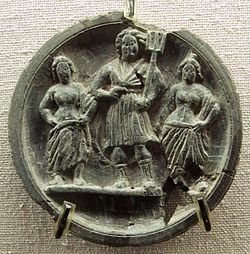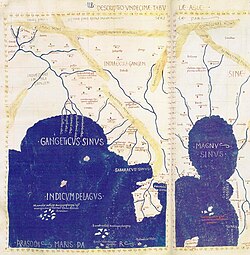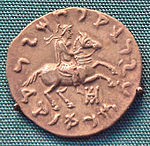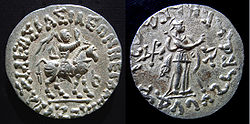
Demetrius I Anicetus, also called Damaytra was a Greco-Bactrian and later Indo-Greek king, who ruled areas from Bactria to ancient northwestern India. He was the son of the Greco-Bactrian Kingdom's ruler Euthydemus I and succeeded him around 200 BC, after which he conquered extensive areas in what is now southern Afghanistan, Iran and Pakistan and India.

Menander I Soter, was a Greco-Bactrian and later Indo-Greek King who administered a large territory in the Northwestern regions of the Indian Subcontinent from his capital at Sagala. Menander is noted for having become a patron and may convert to Greco-Buddhism and he is widely regarded as the greatest of the Indo-Greek kings.

The Indo-Greek Kingdom, or Graeco-Indian Kingdom, also known historically as the Yavana Kingdom (Yavanarajya), was a Hellenistic-era Greek kingdom covering various parts of modern-day Afghanistan, Pakistan and northwestern India. This kingdom was in existence from c. 200 BC to c. 10 AD.

Apollodotus I Prakrit in the Kharoshti script: maharajasa apaladatasa tratarasa) was an Indo-Greek king between 180 BC and 160 BC or between 174 and 165 BC who ruled the western and southern parts of the Indo-Greek kingdom, from Taxila in Punjab to the areas of Sindh and possibly Gujarat.
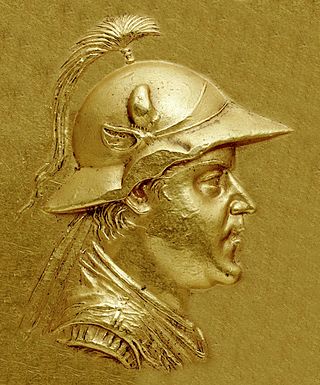
Eucratides I was one of the most important Greco-Bactrian kings. Eucratides overthrew the Euthydemid dynasty and restored the Diodotids to power. He fought against the easternmost Hellenistic and Indian rulers in India, holding territory in the Indus and as far as Barigaza until he was finally defeated by Menander and pushed back to Bactria. Eucratides minted a vast and prestigious coinage, suggesting a rule of considerable importance and prosperity. His son, Heliocles I, was the last Greek king to rule in Bactria, as the Yuezhi overran the country c. 120 BC.

Indo-Scythians were a group of nomadic Iranian peoples of Scythian origin who migrated from Central Asia southward into the northwestern Indian subcontinent, precisely into the modern-day South Asian regions of Afghanistan, Pakistan and northern India. The migrations persisted from the middle of the 2nd century BCE to the 4th century CE.

Strato I Dikaios also known as Stratha in Sanskrit, was a Yavana King, the son and successor of Menander, Strato’s mother, Agathoclea ruled as Queen Mother and regnant for Strato until 120 BCE, when he was of age to succeed his father. He was dynastically succeeded by his son, Menander II.
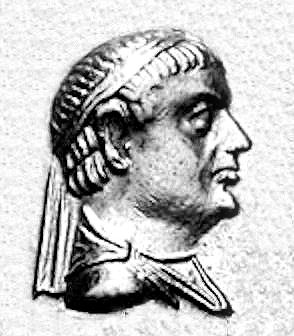
Apollodotus II was an Indo-Greek king who ruled in the western and eastern parts of Punjab. Bopearachchi dates him to c. 80–65 BC, and R. C. Senior to c. 85–65 BC. Apollodotos II was an important ruler who seems to have re-established the Indo-Greek kingdom to some extent of its former glory. Taxila in western Punjab was reconquered from nomad Scythian rule.

Diomedes Soter or Diodotus was an Indo-Greek king and possible claimant Greco-Bactrian King who may have attempted to reconquer the lands north of the Hindu Kush. The places where his coins have been found seem to indicate that his rule was based in the area of the Paropamisadae, possibly with temporary dominions further east. Judging from their similar portraits and many overlapping monograms, the young Diomedes seems to have been the heir of Philoxenus, the last king to rule before the kingdom of Menander I finally fragmented.
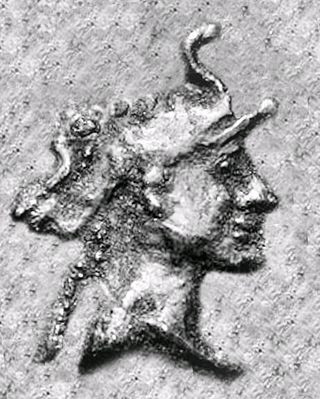
Demetrius III Aniketos is an Indo-Greek king who reigned in the area of Gandhara and Punjab.
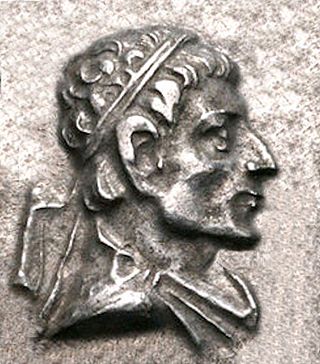
Heliocles II Dicaeus is thought to have been one of the later Indo-Greek kings and a relative of the Bactrian king Heliocles I. Current scholarly consensus is that he ruled ca 95–80 BC.

Antimachus II Nikephoros was an Indo-Greek king. He ruled a vast territory from the Hindu-Kush to the Punjab around 170 BCE. He was almost certainly the eponymous son of Antimachus I, who is known from a unique preserved tax receipt. Bopearachchi dated Antimachus II to 160–155 BCE on numismatical grounds, but changed this to 174–165 BCE after the tax receipt was revealed to synchronise his reign with that of Antimachus I. R. C. Senior has not dated Antimachus II but thinks that his coins were possibly Indian issues of Antimachus I, despite their different epithets and coin types.
Within the Indo-Greek Kingdom there were over 30 kings, often in competition on different territories. Many of them are only known through their coins.

The Indo-Greeks practiced numerous religions during the time they ruled in the northwestern Indian subcontinent from the 2nd century BCE to the beginning of the 1st century CE. In addition to the worship of the Classical pantheon of the Greek deities found on their coins, the Indo-Greeks were involved with local faiths, particularly with Buddhism, but also with Hinduism and Zoroastrianism.

Indo-Greek art is the art of the Indo-Greeks, who reigned from circa 200 BCE in areas of Bactria and the Indian subcontinent. Initially, between 200 and 145 BCE, they remained in control of Bactria while occupying areas of Indian subcontinent, until Bactria was lost to invading nomads. After 145 BCE, Indo-Greek kings ruled exclusively in parts of ancient India, especially in Gandhara, in what is now present-day the northwestern Pakistan. The Indo-Greeks had a rich Hellenistic heritage and artistic proficiency as seen with the remains of the city of Ai-Khanoum, which was founded as a Greco-Bactrian city. In modern-day Pakistan, several Indo-Greeks cities are known such as Sirkap near Taxila, Barikot, and Sagala where some Indo-Greek artistic remains have been found, such as stone palettes. Some Buddhist cultural objects related to the Indo-Greeks are known, such as the Shinkot casket.By far the most important Indo-Greek remains found are numerous coins of the Indo-Greek kings, considered as some of the most artistically brilliant of Antiquity. Most of the works of art of the Greco-Buddhist art of Gandhara are usually attributed to the direct successors of the Indo-Greeks in Ancient India in the 1st century CE, such as the nomadic Indo-Scythians, the Indo-Parthians and, in an already decadent state, the Kushans. Many Gandharan works of art cannot be dated exactly, leaving the exact chronology open to interpretation. With the realization that the Indo-Greeks ruled in India until at least 10-20 CE with the reign of Strato II in the Punjab, the possibility of a direct connection between the Indo-Greeks and Greco-Buddhist art has been reaffirmed recently.

The sources used to reconstruct the history of the Indo-Greeks are few and disparate, leading to much uncertainty about the precise state of the Indo-Greek kingdom and its chronology. Sources related to the Indo-Greeks can be classified into various categories: ancient literary sources from both the West and the Indian world, archaeological sources from the general area of present day Pakistan, Kashmir and North Indian states of Punjab, Haryana, Himachal Pradesh, Uttar Pradesh & Bihar, and numismatical sources, which are abundant and well-preserved but often rather cryptic.

The Greco-Bactrian Kingdom or simply Greco-Bactria was a Hellenistic-era Greek state, and along with the Indo-Greek Kingdom, the easternmost part of the Hellenistic world in Central Asia and the Indian subcontinent. It was founded in 256 BC by the Seleucid satrap Diodotus I Soter and lasted until its fall c. 120 BC with some cities still controlled by Greek kings such as Hermaeus Soter in what is today Kabul. It was ruled by the Diodotid dynasty and the rival Euthydemid dynasty.

The Yavana Era, or Yona was a computational era used in the Indian subcontinent from the 2nd century BCE for several centuries thereafter, probably starting in 174 BCE. It was initially thought that the era started around 180-170 BCE, and corresponded to accession to the Greco-Bactrian throne of Eucratides, who solidified Hellenic presence in the Northern regions of India. The Greeks in India flourished under the reign of the illustrious, Menander - greatest of the Yavana rulers, who campaigned as far as Pataliputra in Eastern India. It is now equated with the formerly theorized "Old Śaka era".

The Post-Mauryan coinage of Gandhara refers to the period of coinage production in Gandhara, following the breakup of the Maurya Empire. When Mauryan central power disappeared, several small independent entities were formed, which started to strike their own coins, defining a period of Post-Mauryan coinage that ends with the rise of the Gupta Empire in the 4th century CE. This phenomenon was particularly precocious and significant in the area of Gandhara in the northwest, and more particularly in the city of Taxila, in modern-day Pakistan.

Post-Mauryan coinage refers to the period of coinage production in India, following the breakup of the Maurya Empire.




